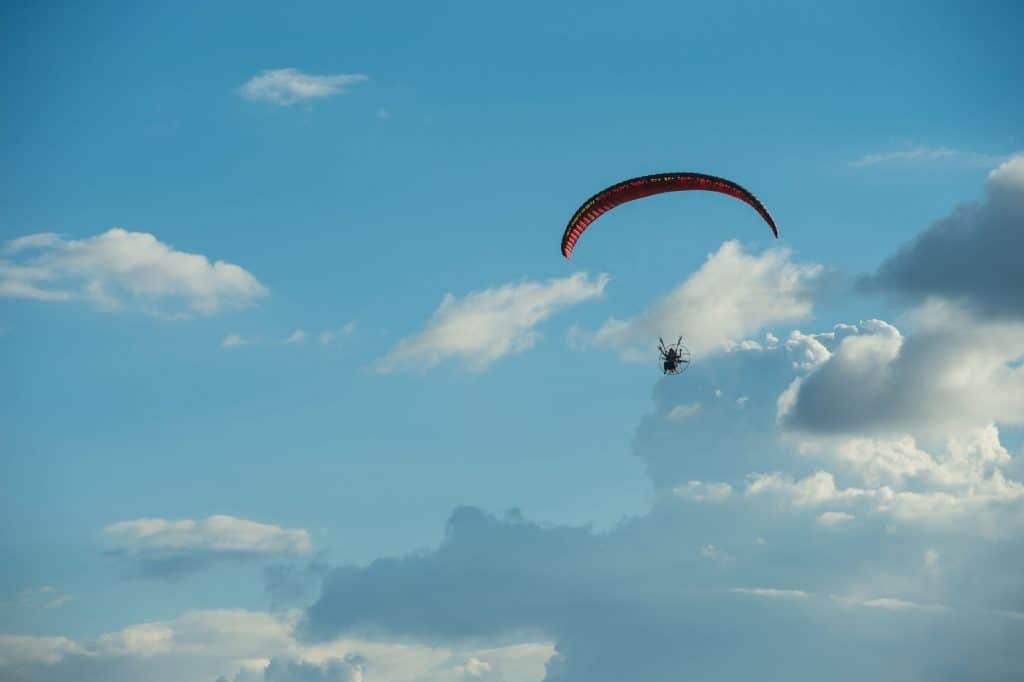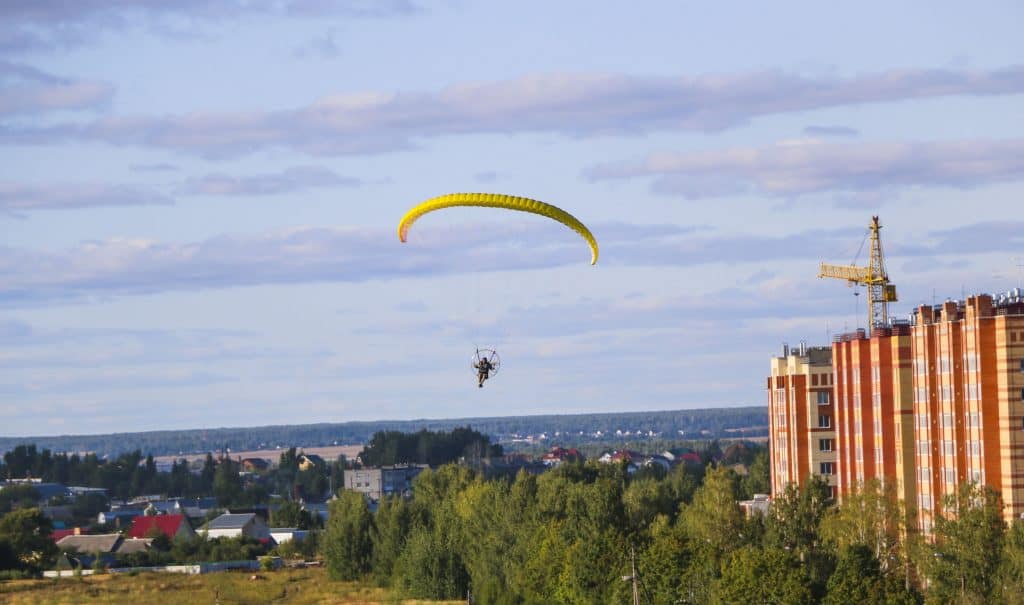
Anyone who has ever flown a paramotor has asked themselves the question “How high can I get on this thing?” I know I’ve asked myself that question before.
So, how high can paramotors fly? Paramotors can be flown to a height of 18,000 feet, but the air is dangerously thin. Most paramotor flights only reach heights of 1000 feet. It is generally safer to fly high than low to the ground. When flying low, the reaction time is reduced if a problem arises before hitting the ground.
The Highest Anyone Has Ever Flown
According to the Federation Aeronautique Internationale (FAI), or World Air Sports Federation, the highest anyone has ever flown on any class of paramotor is 9720 meters or 31,890 feet.
On September 18th, 1994, a Frenchman by the name of Serge Zin flew to an altitude of 9720 meters. At this extreme height, Serge needed to wear an Oxygen mask, as he would be at an altitude of almost 900 meters higher than Mount Everest.
Serge Zin has also held many other records such as:
- Fastest speed over a straight course (March 11, 1993),
- Fastest speed over a closed circuit (August 2nd, 1989),
- The two-person altitude record (August 4th, 1991),
All of which were ratified, but have since been superseded.
To see more records on Microlights and Paramotors, click here.
How to Prepare to Fly Paramotors Higher than Normal
When looking to fly paramotors high in the sky, there are a few things you should know. Not following these tips could lead to serious injury or death, so pay attention:
Oxygen Masks
Oxygen gets thinner the higher up you go. So when flying at high altitudes, you need to know how much oxygen you need.
The standard percentage of oxygen in the air is just about 20% at ground level.
Supplemental Oxygen is needed for flying at heights of 12,500 ft (3810 meters) and above, for more than 30 minutes,. At this height, the oxygen level has decreased to about 13%.
All pilots should be using oxygen masks at all times above 14,000 ft (4267 meters). At this height, the percentage of oxygen in the air is even lower, at 12.3%.
If you want to fly higher than this, an oxygen mask that simply supplements the oxygen in the air will not be enough. You should consider getting a closed breathing system that will not rely on there being some oxygen in the air, or the air being thick enough to breathe comfortably.
Clothing
As a general rule, the higher you go, the colder it will get. So, how can you prepare for the cold weather?
First of all, buy some paramotoring gloves. They’re made specifically for the sport of paramotoring, and they tend to do an excellent job of canceling out the effect of wind at great heights, keeping your fingers warm.
When considering clothing, also consider compression undergarments.
“The main reason compression clothing exists is to improve blood circulation during physical exercise. The goal is to compress muscles so that they, while contracting, constrict veins. This then enables blood to reach the heart more easily while improving muscle oxygenation. Another benefit is that compressive apparel prevents the buildup of lactic acid in the muscles during training/competitions, and helps the body to recuperate more rapidly after it and reduces muscular inflammation.”
altitude-blog.com
This boost to oxygenation can help keep you awake and alert when you fly at these great heights.
Finally, for your outer layer, begin by doing some local research. Check the average and forecast temperatures for the height at which you plan to fly. If you need to wrap up warm, winter clothes such as snow pants and heavy jackets are an excellent place to start.
Altitude Sickness.
There is no way to completely prevent the ill effects of extreme altitudes, however, you can prepare and keep yourself as safe as possible with these tips from adventurealternative.com.
- Be well acclimated to around 6500m, training over the course of months
- Keep well hydrated by drinking over 3 liters per day.
- Stay above 7000m for as short a time as possible.
- Descend if unwell even with apparently minor illness.
- Take rest periods as low as possible, certainly below 5500 meters
By following these tips, you may be able to minimize the symptoms of altitude sickness and can have an enjoyable ride while flying high.
Which Paramotors Can Fly the Highest?

When looking to buy a paramotor that can fly high, many paramotors can do the job. But our suggestion for high climbing paramotors here at Outdoor Troop is a Flat Top paramotor.
Flat Top, known for paramotors such as the Flat Top 120, Flat Top Ninja, and the Flat Top 200 Super, are professionals at their craft. The paramotors that they make are all practically silent, making very little noise. However, these quiet paramotors also have an incredibly high altitude ceiling.
| Flat Top 120 | Flat Top Ninja | Flat Top 200 Super | |
| Altitude Ceiling | 10,000 feet | 18,000 feet | 18,000+ feet |
| Cost of Paramotor | $6,195 | $7,900 | $8,200 |
These paramotors have more than enough horsepower and thrust to make maneuvering at high altitudes a breeze.
When to Fly Paramotors at High Altitudes
As always, when going to fly your paramotor, make sure that the weather will be good that day. There are a wide array of paramotoring apps that can help you get a good grasp on the weather, such as the Windfinder app. Another good app to get is the WindAlert app.
These apps can give you good information on local wind speeds, and any potential weather problems.
Another stellar app to have is the Flyskyhy app, which can calculate the wind speeds around you as you are flying.
You should only fly paramotors at high altitudes after building up a tolerance to it slowly over time. You should be prepared, and have the proper breathing equipment and clothes to comfortably fly at your planned heights.
You should make flying at high altitudes an event, one that you prepare for, invest time and money in, and be willing to push back should weather not be permitting.
Related Questions
How far can a Paramotor fly? Some paramotor pilots fly hundreds of miles by making pit stops to fuel up. However, most flights will only last about 10 miles. The Icarus Trophy, a cross-country paramotoring race spans 1,000 miles, and hundreds of miles are flown every day by the pilots who are gunning to win it.
Do you need a license to fly a Paramotor? Paramotoring does not require a license. However, paramotorists must still abide by the rules and regulations set out by the FAA regarding Ultralights. These include laws regarding airspace, modifications to the paramotors themselves, and laws regarding commercial use of paramotors, to name a few.
